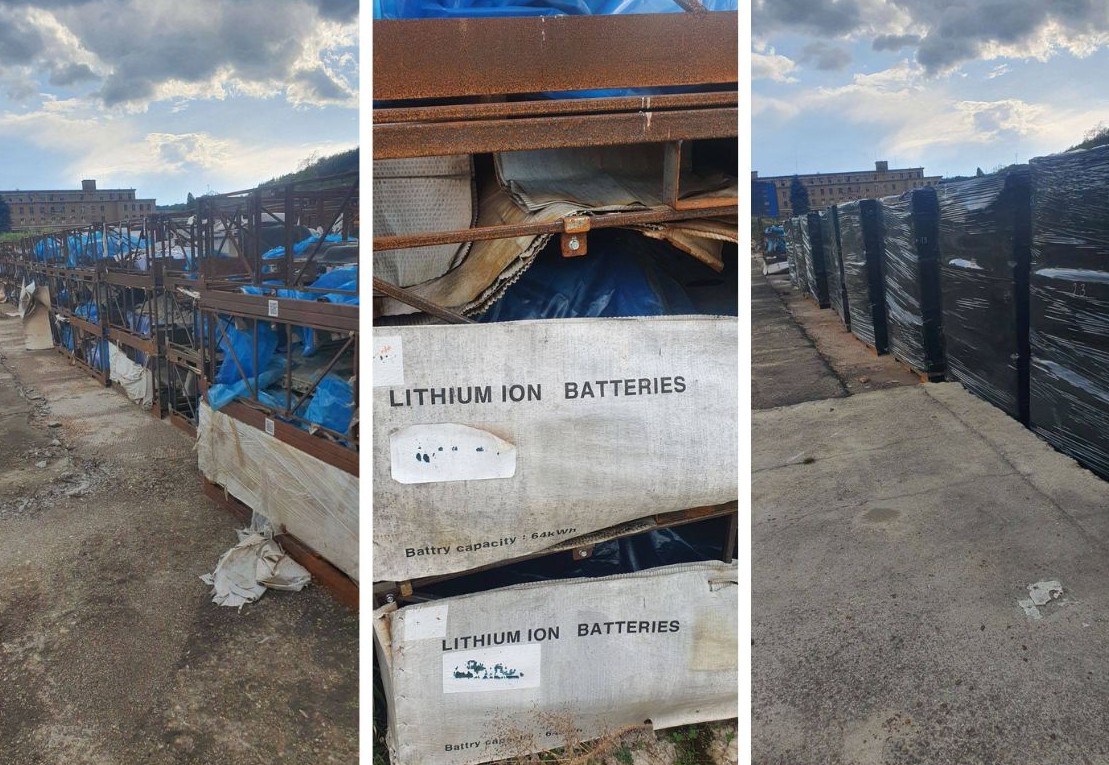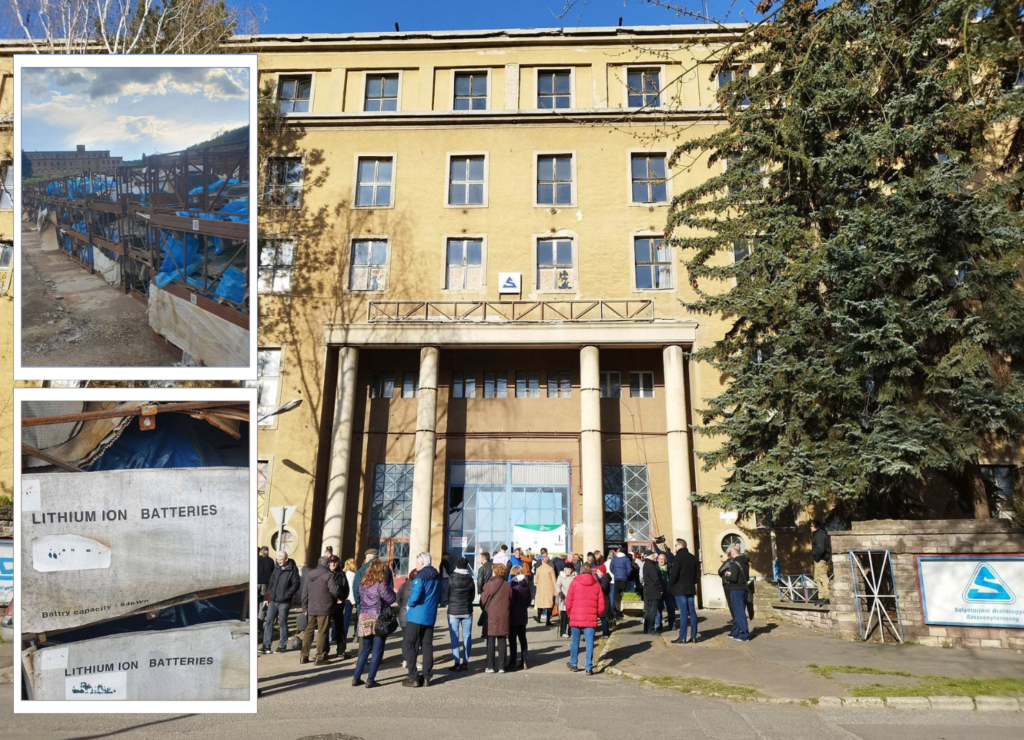The https://english.atlatszo.hu use cookies to track and profile customers such as action tags and pixel tracking on our website to assist our marketing. On our website we use technical, analytical, marketing and preference cookies. These are necessary for our site to work properly and to give us inforamation about how our site is used. See Cookies Policy
Photos prove that battery waste is stored at the Éltex site in Salgótarján
A few weeks ago, Greenpeace Hungary reported that carcinogenic pollutants were flowing into the Salgó stream near the Salgótarján site of Éltex Kft. According to the company’s statement, the pollution did not come from them, and they also wrote that they do not yet carry out waste treatment at their site. However, photos obtained by our editorial office show a lithium-ion battery on the packaging of waste stored at the Salgótarján site. The authorities, who were notified by Greenpeace more than a month ago, have so far not provided any investigative data on the origin, cause and extent of the pollution detected in the Salgó streams.
In mid-March, residents detected pollution in the Salgó stream and informed Greenpeace Hungary experts. On 18 March, the environmental organisation took a wastewater sample and carried out an accredited laboratory test. According to their report, the effluent from the waste treatment site of Éltex Ltd. contained carcinogenic vinyl chloride and toxic dichloroethylenes. Greenpeace immediately informed the competent authorities, who have not yet commented on the pollution.

The company answered in a statement
After the Greenpeace statement, Éltex Ltd. also issued a statement, claiming that the pollutant did not come from its site. The company’s statement also says: “Éltex Ltd. is not yet carrying out waste treatment activities at its Salgótarján site, as we still need to complete investments to obtain the official permit”, adding that the company is not yet operating in the Salgótarján site. ‘does not dismantle or process batteries or battery waste’.
Greenpeace Hungary responded to the company’s claims. They reiterated that their on-site experience showed that the pollution was coming from the Éltex Ltd. site because the sampling point is located in the Éltex Ltd. area. In addition, they said it was unlikely that volatile vinyl chloride would be present in the stream water at such concentrations in leachate from a previous spill.
Discarded batteries spotted on-site
Atlatszo previously reported that the disaster management authority banned Éltex Ltd. from waste management activities in 2023. The decision, which imposed a HUF 1 million fine, found that fire safety equipment was missing at the site, where 600 tonnes of flammable battery waste was previously stored.
The disaster management authority’s decision banned waste collection, storage and recovery “until the fire safety requirements are met, but for a maximum of 45 days”, and set a deadline of 31 March and 30 April 2023 for the certification of fire safety compliance.
However, the company’s notice of 16 April 2024 indicates that they will need to make additional investments to obtain a permit to continue the activity. We have therefore submitted an FOI request to the disaster management authority for further decisions on the inspection of the site and the activities carried out there.
However, a government decision issued in 2024 imposing a fine of HUF 100,000 refers to waste management activities. According to this, Éltex Ltd. declared that it had not stored waste on the site since 26 April 2023. The government agency then carried out an on-site inspection. They reported that “the amount of waste stored there had significantly decreased compared to the previous period, but was not empty, as claimed by the Respondent in its statement in the present proceedings.”
The presence of battery waste is confirmed by photos obtained by Átlátszó in April this year showing the waste currently stored at the Salgótarján site, which bears the inscription LITIUM ION BATTERIES on the packaging.

Lithium-ion battery label on the packaging of waste at the Éltex Kft. site in Salgótarján. (Photos by our reader)
The documents and photographs show that Éltex is still managing waste on the site – i.e. even if there is no “dismantling” or “processing”, the company is still storing batteries.
Moreover, the photos show that the waste is being stored outdoors, even though the company has already been fined HUF 1.3 million by the Nógrád County Government Office for storing 32 tonnes of lithium-ion batteries “without any protection” in the open.
We wrote to Éltex Ltd. to ask what waste they were currently storing and what activities they were carrying out at the Salgótarján site. The company failed to respond to our repeated requests.
The investigation into the pollution is still ongoing
On 29 April 2024, Éltex Ltd. published a post on its Facebook page about water pollution, stating that it is not involved in the pollution of the Salgó stream, based on “authentic measurement results”.
We have contacted the Metropolitan Directorate of Disaster Management, the water authority investigating the case. They said the investigation is ongoing and they can only provide information on the investigation reports and findings once the procedure has been completed.
Atlatszo has also contacted Greenpeace for comment on the conclusions drawn from the “credible” measurements in Éltex’s post. Gergely Simon, Greenpeace’s chemical expert said that the company’s statement refers to a sampling on 16 April, when official measurements no longer showed significant contamination compared to the measurements of Greenpeace.
“We do not see any correlation between the 18 March spill and the 16 April sampling results, especially as there was no visible pollution comparable to the March spill during this period.”
The expert added that vinyl chloride is a volatile substance, and “no trace of it remains one month after the spill. Thus, Éltex’s claim that this makes ‘Greenpeace’s allegations unsubstantiated’ is misleading the public.”
Translated by Zita Szopkó. The original, more detailed Hungarian version of this story was written by Zsuzsa Bodnár and can be found here.

